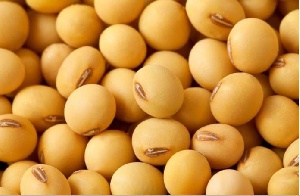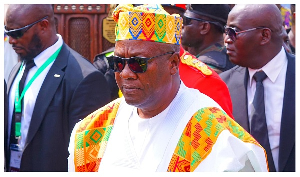There is a growing unmet market demand and unused processing-export capacity of soya beans in the country, Mr Mohammed Tufero, a Deputy Minister of Food and Agriculture has disclosed.
Ghana’s annual soyabean production potential is 700,000 metric tons covering an area of about 250,000 hectares, while the area under cultivation is about 125,000 hectares.
The country’s combined processing and export gap of soyabeans is 228,000 metric tons, while imports, mainly processed soya meal, amounted to about 200,000 metric tons of grain equivalent leading to an unmet market demand.
The Deputy Food and Agriculture Minister in charge of Crops, addressing a stakeholder meeting on the theme: “Soyabean – A strategic crop for poverty reduction and enhanced food security in Northern Ghana,” said, the main bottleneck was the lack of capacity for medium and smallholder farmers to increase their annual soyabean production with an additional 200,000 metric tonnes.
He said the supply gap provided an opportunity for job creation, poverty reduction and food security in the country, especially in the northern savannas, which produced about 90 per cent of the country’s soyabean and were among the deprived regions of Ghana.
However, the Deputy Minister stated that the domestic production was on subsistence basis under rainfed conditions which were constrained by erratic rainfall because of climate change, lower crop yields, high cost of production and low elasticity of technical efficiency which often resulted in low import-substitution.
The meeting was part of strategies under the Sustainable Soyabean Production in Northern Ghana (SSPiNG Project) being implemented in 16 districts in the five Northern Regions of Ghana by the International Institute of Tropical Agriculture (IITA), YARA Ghana, Wageningen University, the Netherlands and Felleskjopet Rogaland Agder, Norway, with support from the Ministry of Food and Agriculture, Ghana.
SSPiNG is a four-year project with funding from the Norwegian Agency for Development Cooperation (NORAD).
The project envisions “to materialise the multiple potential benefits of soyabean to smallholder farmers and other value chain actors engaged in the food and feed sectors in Ghana.’’ It is aligned with the Government’s programme, “Investing for Food and Jobs’’.
The primary beneficiary of the project includes 100,000 smallholder farmers (SHFs) who, by year four of the project, will generate a total gross income of $60 million per year with 50 per cent currently on average growing 0.4 hectares of soyabean annually in the 16 districts of Northern Ghana.
With over 300 extension officers and 500 farmer associations and building on existing structures, the project also facilitates Public-Private Partnerships (PPP) around market access, inputs information, mechanisation, finance services, and capacity development demands.
The Deputy Food and Agriculture Minister said the production of soyabean production in Ghana had increased steadily from 113,000 metric tonnes in 2009 to a little over 200,000 metric tonnes in 2020, while demand was more than about 300,000 metric tonnes.
Despite the high production, he said, the processing industry was still confronted with several challenges, including insufficient materials for processing, limited access to credit, and insufficient equipment.
To address the low soyabean yields under smallholder farming conditions, Mr Tufero said, there was the need to facilitate the soya value chain such that smallholder farmers would be linked to input and output markets, finance, equipment, and information through larger commercial farmers and aggregators who had the capacity and incentives to invest in smallholder production.
“These linkages will build the capacity of smallholder farmers to increase the efficiency of their farm businesses with improved production and post-harvest handling practices with an emphasis on processing to meet the ever-increasing demands of the value chain,” he said.
Professor Samuel Adjei-Nsiah, Project Coordinator, in a presentation, said the project was conceptualised around the lack of communication and coordination among soyabean value chain actors in terms of organisation, information management and decision-making tools to ensure that demand for input-output markets and services were efficiently matched with supply.
In an interview with the Ghana News Agency, Prof. Adjei-Nsiah said the challenges with soyabean production was attributable to the lack of policy and strategy on the value chain.
He said: “All the policies that in the value chain currently are ad-hoc policies. For instance, Ghana produces non-GMO soya which creates a niche market for global soyabean and because of this, there is an influx of foreigners to buy soya for export. Some producers are of the view that, the situation is depriving them of their livelihood.”
The Project Coordinator said, there was a need for a comprehensive data on the production of soyabeans in Ghana, and a strategic policy document to guide the industry, explaining that “we need to know the local and export demand, capacity among others to before restrictions are” put on exports.”
Business News of Thursday, 2 February 2023
Source: GNA

















